Art therapy has become a wonderful way to help children with autism develop their social skills. It opens up a colorful world for self-expression and communication! By weaving creative activities into therapy, kids can share their feelings and connect with their peers in meaningful ways.
But here’s a thought: how can we make sure these artistic activities truly fit each child’s unique needs? It’s all about nurturing both emotional and social growth. In this article, we’ll explore ten impactful strategies that showcase the amazing benefits of art therapy in helping young people with autism build their social skills. Together, we can pave the way for a brighter, more connected future! Let’s dive in!
Rori Care - ABA Treatment is all about blending ABA intervention with art support to craft personalized care plans for kids with autism. This creative approach employs art therapy and social skills development in autism as a fun and engaging tool, turning therapy sessions into enjoyable experiences that truly make a difference. By incorporating art therapy and social skills development in autism, clinicians can address the emotional and social needs of each child, fostering a nurturing environment that enhances self-expression and communication skills.
Research shows that art therapy and social skills development in autism can significantly enhance interpersonal skills and emotional management, making it a fantastic complement to traditional ABA methods. Take Alex, for instance—a 10-year-old with autism. Through drawing, he found a way to express his emotions verbally, which is so important for connecting with others. Plus, the aspect of art therapy and social skills development in autism encourages peer support, allowing kids to learn from one another and develop essential skills like turn-taking and teamwork.
This holistic approach not only enriches the therapeutic experience but also promotes art therapy and social skills development in autism, helping young individuals thrive socially. And let’s not forget about the vital role of caregiver education! By equipping caregivers with ABA principles and strategies, they can better support their child’s behavioral goals. When caregivers actively participate in their child’s treatment, they can make informed choices that positively impact progress, leading to better behavioral outcomes and a more harmonious family dynamic.
The structured program development ensures that these treatments are tailored to meet each child’s unique needs, further enhancing the effectiveness of the interventions. So, let’s explore this journey together! We’re here to help you every step of the way!
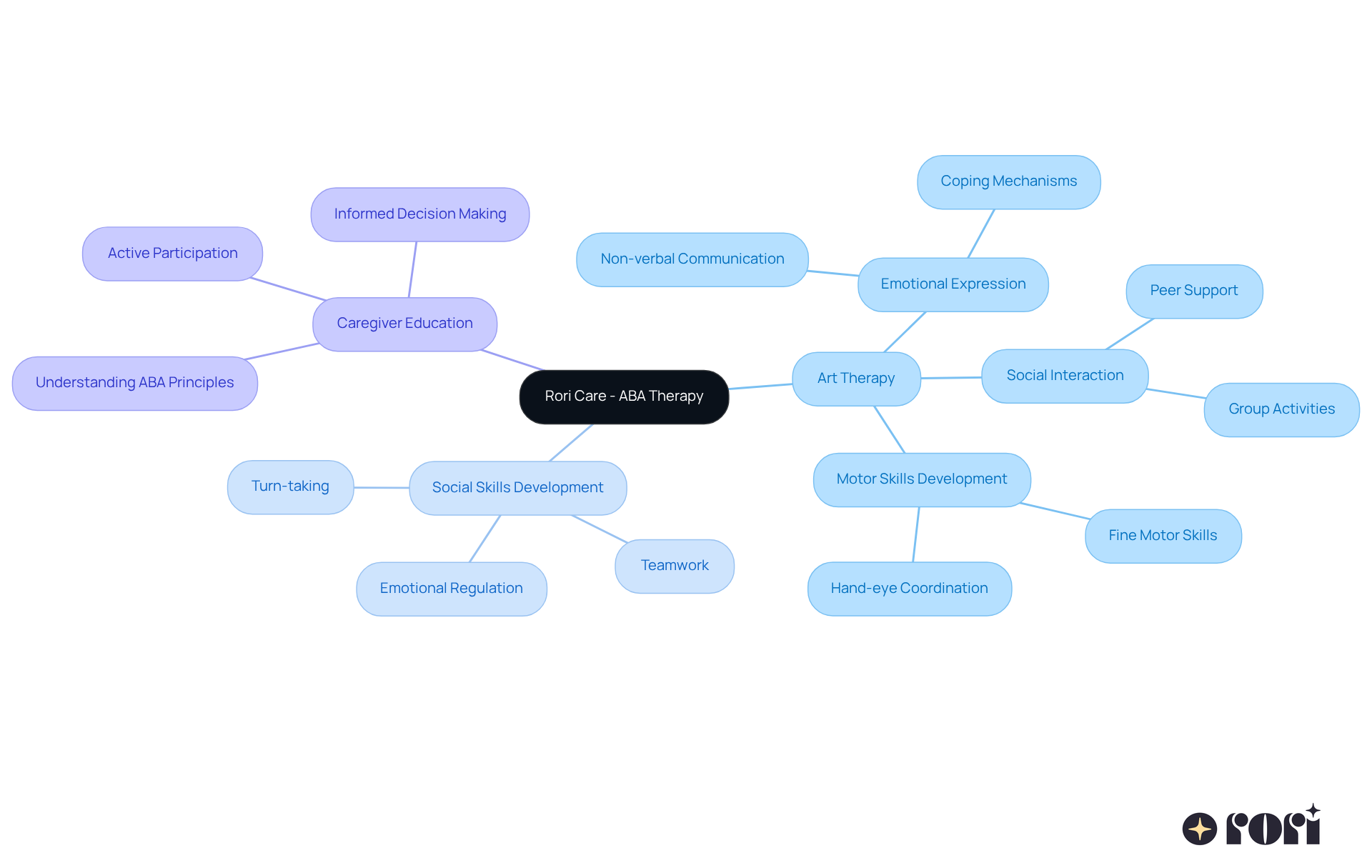
Art interventions can be a game-changer for youth with autism, particularly in terms of emotional regulation, communication, and art therapy and social skills development in autism. Imagine your child participating in creative activities that allow them to express their feelings without words—how empowering is that? Recent studies show that structured drawing programs can lead to real improvements in emotional-social responsiveness for preschoolers with Autism Spectrum Disorder (ASD). Participants often show better emotional regulation, with clear differences noted in assessments before and after the intervention.
But that’s not all! Artistic counseling also boosts self-esteem and gives kids a sense of accomplishment. It opens up a world where they can explore their feelings and experiences in a creative way. By weaving drawing-based strategies into intervention programs, practitioners can really enhance communication skills and improve the overall quality of life for youth with ASD. This holistic approach not only helps with emotional expression but also encourages social engagement, making art therapy and social skills development in autism a vital part of the developmental journey for individuals with autism.
At Rori Care, we truly understand the unique challenges families face when navigating autism. That’s why we offer a range of mental health support services, including:
Our dedicated clinical leadership team is passionate about promoting neurodiversity and ensuring that youth thrive through tailored programs and caregiver support. By integrating art-based support into our comprehensive strategy, we aim to help families overcome hurdles and nurture youth development with compassion and expertise.
Let’s explore this together! We’re here to help you every step of the way!
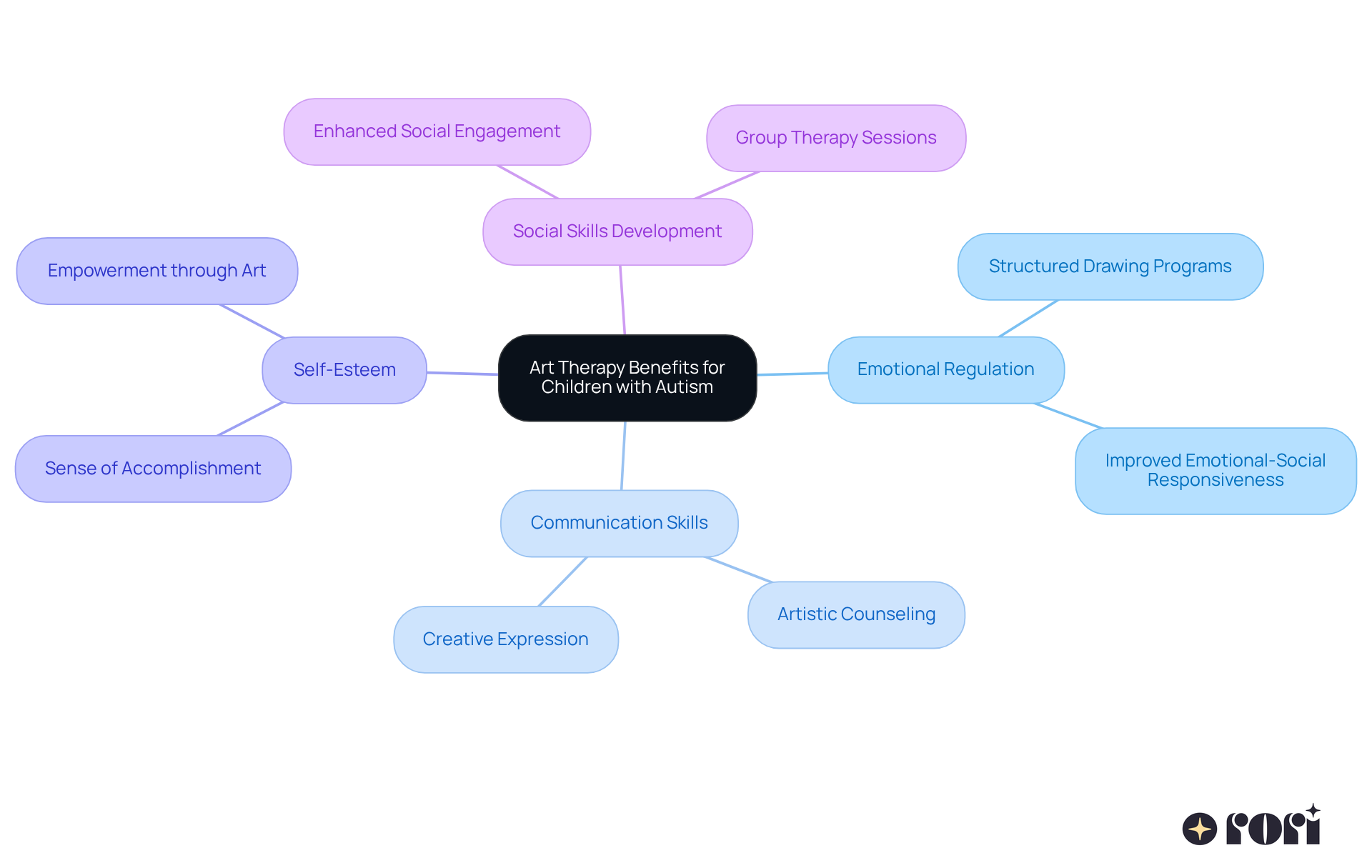
Research from the Sunfield Center shows just how impactful art therapy and social skills development in autism can be for children. It’s not just about creating something beautiful; engaging in organized art activities can really boost their interactions, emotional regulation, and communication skills. At Rori Care, our clinical leadership team is all about neurodiversity and helping youth thrive. We truly believe that art therapy and social skills development in autism are key components of a multidisciplinary approach for ASD.
Through artistic expression, kids can enhance their essential skills for connecting with others, which aligns with art therapy and social skills development in autism. This is so important for their overall growth in social situations! By incorporating art therapy and social skills development in autism into treatment strategies, we can help young people navigate social settings more effectively, especially when we prioritize early intervention. Let’s explore this together and see how we can support our kids in their journey!
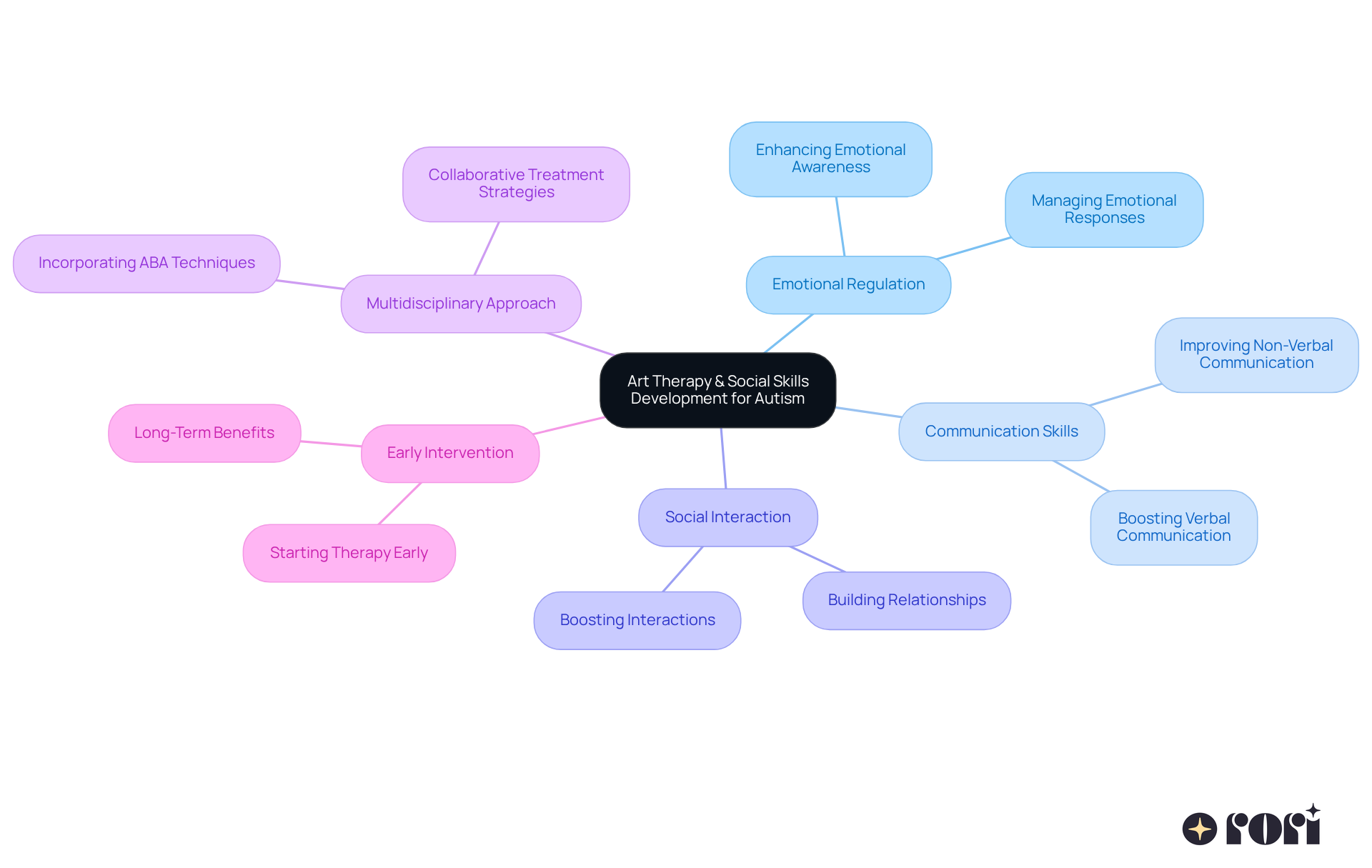
Combining art therapy and social skills development in autism with ABA therapy can significantly enhance involvement and education for individuals with autism. By weaving in creative activities during ABA sessions, therapists can capture a young person's interest, motivating them to join in actively. This patient-focused approach tailors to each child's unique needs, fostering the development of essential social skills in a calm and nurturing environment.
For instance, using art projects as rewards not only encourages positive behavior but also reinforces learning goals, making the therapeutic journey more effective. Research indicates that art therapy and social skills development in autism can improve communication and social interactions, underscoring the role of creative activities in promoting cognitive flexibility and emotional regulation. As one therapist noted, "Creative activities provide opportunities for young individuals to express themselves, making therapy a more engaging and fulfilling experience."
And let’s not forget the role of caregivers! When they actively participate, it can lead to significant progress in 90% of young individuals, especially when the recommended hours are fully utilized. However, it’s important to recognize that some individuals with autism might face sensory challenges during creative activities, which can impact their engagement. Addressing these hurdles can further enhance the effectiveness of artistic interventions in supporting young people's learning and emotional growth.
So, let’s explore this together! If you’re a parent navigating these waters, remember that you’re not alone. We’re here to help you every step of the way!

Creative expression through art therapy and social skills development in autism is a wonderful way for kids with autism to enhance their social skills! When young people dive into creative activities, they get to explore their feelings and share their thoughts without needing words. This is super important, especially since many on the spectrum face communication challenges. Research shows that kids involved in art therapy and social skills development in autism often experience significant improvements in their interactions with peers. They learn to share their artwork, work together on projects, and express their feelings more clearly. For instance, studies have found that structured art activities can lead to better community involvement and more reliable interactions among youth with autism.
At Rori Care, our clinical leadership team is all about embracing neurodiversity and supporting families with autism. Our compassionate experts truly understand the unique challenges faced by kids on the spectrum, and they work hard to create a nurturing environment where these young individuals can thrive. Plus, art therapy and social skills development in autism help to build a sense of community and belonging, which is crucial for developing social skills. By participating in collaborative art projects, kids not only make friends but also develop essential teamwork skills. Art therapists highlight how important non-verbal communication is in these settings, pointing out that visual expression can fill in the gaps when words fall short. As one art therapist beautifully put it, 'Art enables young individuals to convey what they are unable to articulate, forming bonds that language frequently cannot.' This incredible tool not only sharpens social skills but also nurtures emotional growth, making art therapy and social skills development in autism a truly enriching experience for young people.
Let’s explore this together! We’re here to help you every step of the way!

Research shows that art therapy and social skills development in autism can significantly help young people manage their emotions and improve their communication. Engaging in various artistic activities not only helps them process their feelings but also reduces anxiety, leading to improved emotional responses. For many kids, expressing emotions through creative outlets feels easier, which helps them understand their feelings on a deeper level.
At Rori Care, our clinical leadership team is all about supporting neurodiversity and ensuring every young person thrives. Art therapy and social skills development in autism create a safe space during sessions where kids can build important communication skills. As they talk about their artwork and share their creative journeys, they enhance both their verbal and non-verbal communication abilities. This is so important because it encourages children to express complex emotions and ideas that might be tough to put into words.
Let’s look at some real-life examples. Take Liam, a 9-year-old boy who used mixed media art to explore feelings related to social challenges. This creative process helped him feel less anxious and more willing to join in group activities. Then there’s Emily, an 11-year-old girl with limited verbal communication. After participating in art activities focused on drawing and collage, she showed remarkable progress in expressing herself.
Incorporating artistic activities into treatment not only enhances emotional well-being but also promotes art therapy and social skills development in autism. When kids work together on art projects, they learn to navigate social situations with more confidence, fostering a sense of community and belonging. Research shows that art therapy and social skills development in autism can significantly improve social engagement for individuals with autism, making it a valuable addition to communication support. Overall, the many benefits of art therapy and social skills development in autism play a crucial role in assisting young people with autism in developing their communication skills.
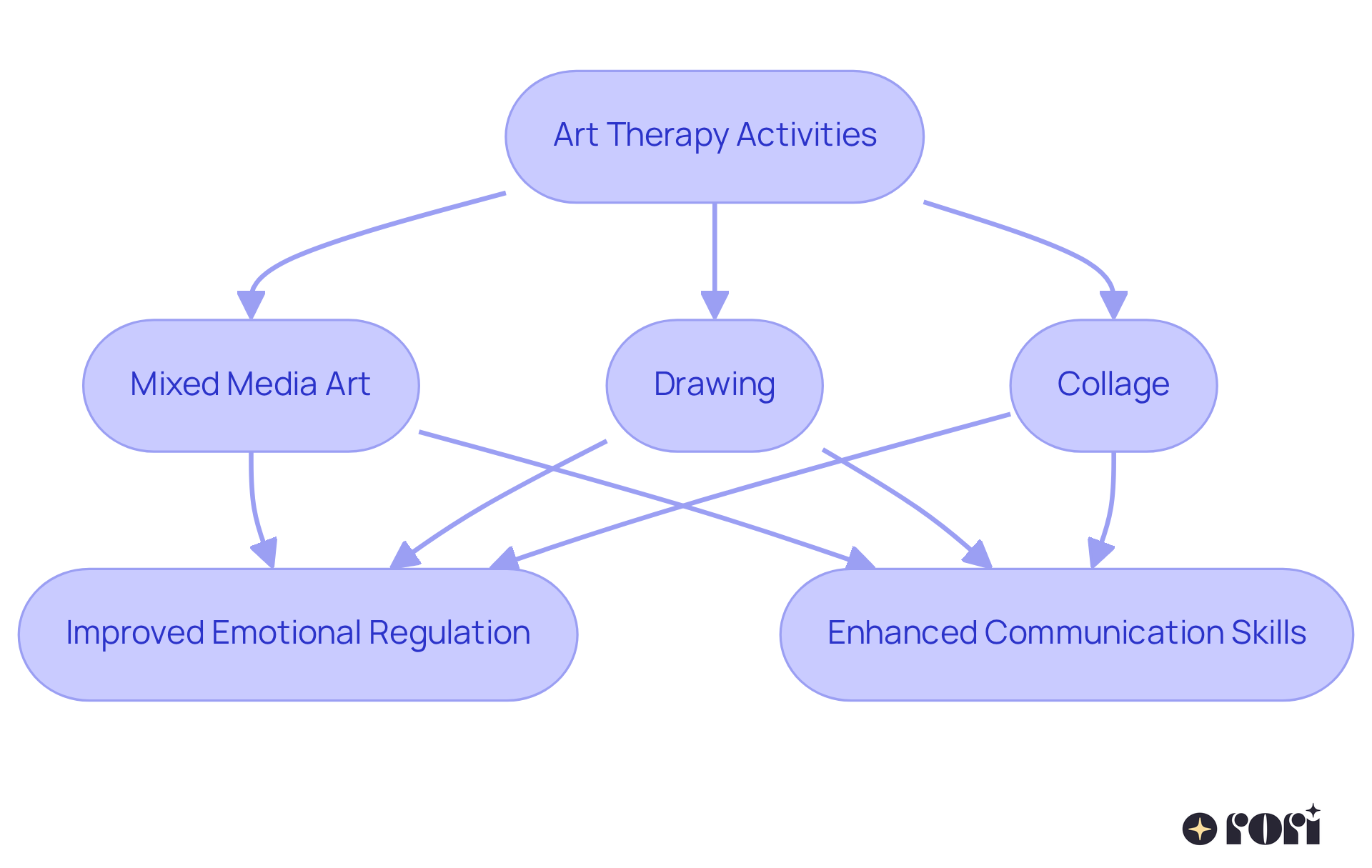
Promoting parent-led art therapy and social skills development in autism can really create nurturing spaces for children with autism. When parents dive into art activities with their little ones, they set up a safe haven for them to express themselves freely. Just think about it: working on joint art projects not only helps kids grow emotionally and socially but also strengthens the bond between parent and child. Simple activities like drawing, painting, or crafting can turn into meaningful moments that boost communication and understanding within the family.
Research shows that kids whose parents are involved in ABA training often see big improvements in social skills, like making eye contact and interacting with peers. By encouraging language use and modeling positive behaviors during these creative sessions, parents can really help enhance their child's communication skills. This teamwork not only benefits the kids but also builds parents' confidence and self-efficacy in supporting their child's development.
There are some fantastic examples of families getting involved in art practices, showing how these shared experiences can lead to lasting positive outcomes. A meta-analysis even highlights moderate to strong benefits for parent-implemented interventions! Dr. Elka Jacobs-Pinson notes that art therapy and social skills development in autism have been found to be advantageous for youth with autism spectrum disorder (ASD) by enhancing communication and lessening symptoms of anxiety. Plus, 77% of participants reported feeling better overall in terms of psychological well-being and communication skills after participating in art therapy and social skills development in autism sessions.
While the benefits are impressive, it’s super important for parents to seek out the right training and support to make these interventions as effective as possible. Being well-prepared helps parents make informed choices that can positively impact their child's progress. Let’s explore this together! We’re here to help you every step of the way!
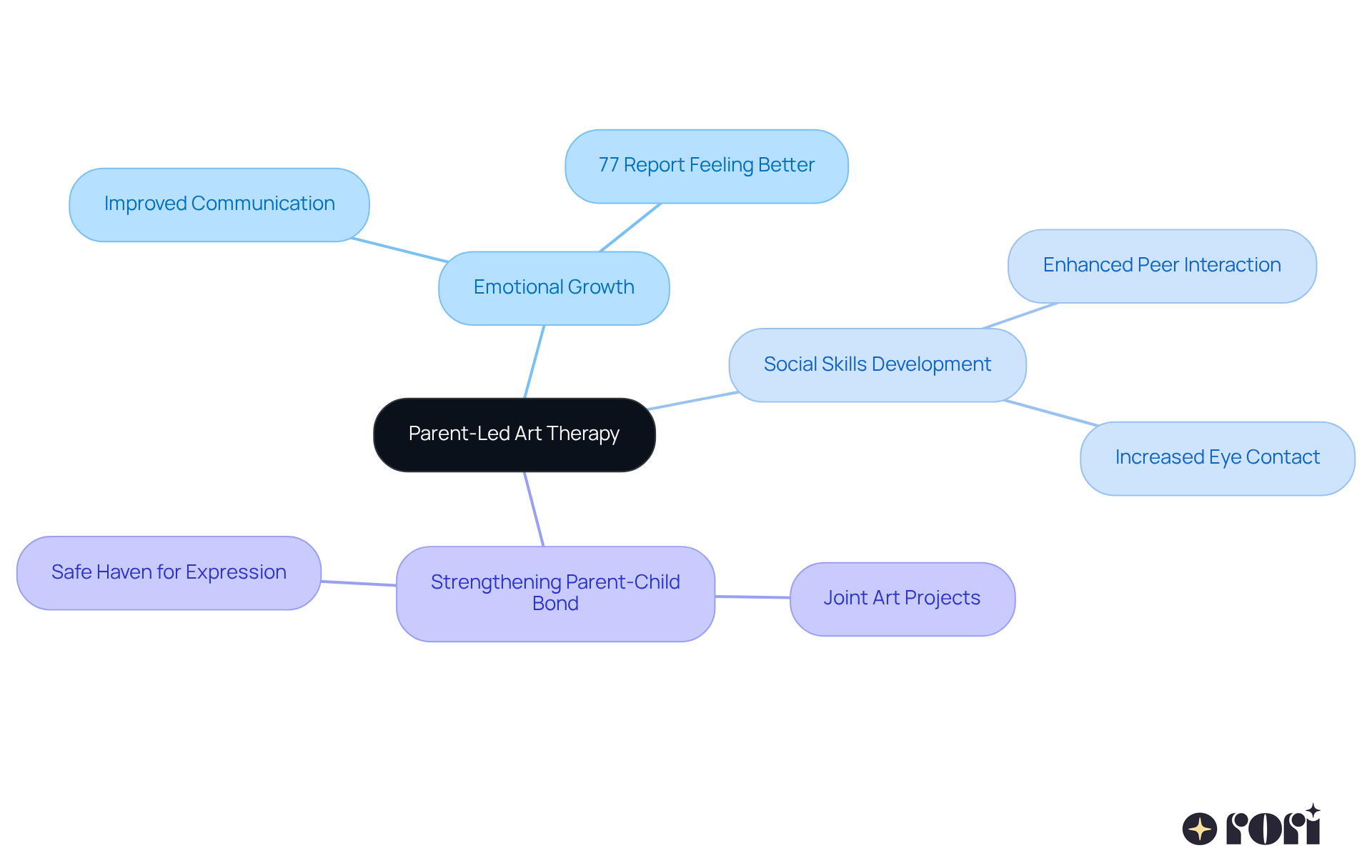
Collaborative art initiatives play a wonderful role in art therapy and social skills development in autism, boosting teamwork and interaction among youth. When kids engage in group art activities, they have the opportunity to collaborate, share resources, and express their thoughts, which are essential components of art therapy and social skills development in autism. Through these fun interactions, young people learn to negotiate, cooperate, and truly appreciate each other’s contributions.
Imagine creating a mural as a team! It’s not just about the art; it’s about feeling that sense of achievement and belonging. This really highlights how collaboration can thrive in community settings. Research shows that these joint initiatives, including art therapy and social skills development in autism, significantly enhance interpersonal skills, with kids demonstrating increased trust and communication abilities.
Educators often remind us that these projects are more than just art-making; they’re unique chances to teach teamwork, respect for different perspectives, and the beauty of collective creativity. As Kathleen, an art teacher, beautifully puts it, "Collaborative art projects in elementary school are not just about creating art; they’re a unique way to teach teamwork, respect for others’ ideas, and the beauty of diverse perspectives."
By diving into these enriching experiences, youth with autism can greatly benefit from art therapy and social skills development in autism, enhancing their social interactions and building meaningful relationships. This aligns perfectly with the principles of early intensive behavioral intervention and caregiver education. So, let’s explore this together and see how we can support our kids in these amazing journeys!

Integrating technology into art therapy and social skills development in autism can really personalize the experience for young individuals, boosting their involvement and motivation. Think about tools like digital drawing apps, virtual reality art experiences, and interactive art platforms—they can truly cater to each child's unique preferences and learning styles. By embracing technology, therapists can craft dynamic and engaging sessions focused on art therapy and social skills development in autism that resonate with these young individuals, making the therapeutic process not just effective but also enjoyable.
Let’s explore this together! Imagine a child who loves to draw but struggles with traditional methods. With a digital drawing app, they can express themselves freely, tapping into their creativity in a way that feels comfortable and fun. Or picture a virtual reality art experience that transports them to a world where they can create without limits. These tools not only enhance engagement but also support art therapy and social skills development in autism by helping to build confidence.
As parents, it’s important to recognize how these innovative approaches can make a difference. By seeking out resources and support, you can help your child thrive in their artistic journey. We’re here to help you every step of the way!

Taking a holistic approach to therapy, including art therapy, can really boost the well-being of youth with autism. It’s all about empowering them to build independence through essential skill development. This comprehensive strategy doesn’t just focus on interpersonal skills and emotional regulation; it also nurtures cognitive and physical growth.
By blending different therapeutic modalities, like art, parents and clinicians can create a supportive environment that nurtures every aspect of a young person’s development. This way, children get the tools they need to thrive in all areas of their lives. Plus, with individualized behavior intervention plans and caregiver education, we can enhance social interactions and communication.
At Rori Care, we truly believe that empowering families is key in this journey. It fosters unity and support in autism care, making the path a little easier for everyone involved. Let’s explore this together! We’re here to help you every step of the way!
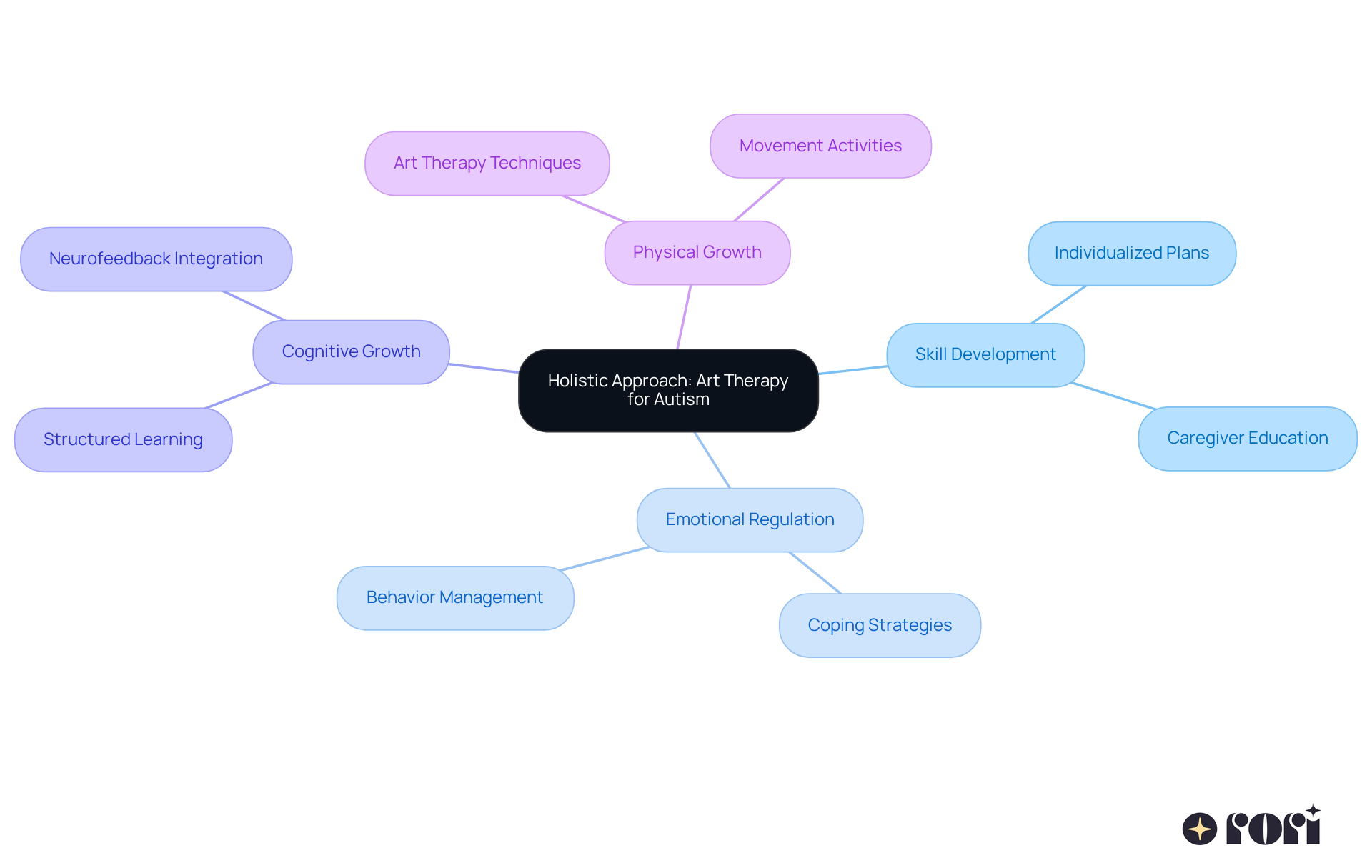
Art therapy shines as a wonderful tool for helping children with autism develop their social skills. By weaving creative expression into therapy, kids can tap into their feelings, improve communication, and engage with others. This approach not only creates a warm and nurturing space but also arms children with vital skills that guide them toward greater independence and social interaction.
Throughout this journey, we see some amazing benefits of art therapy. It helps with emotional regulation, boosts self-esteem, and even encourages teamwork through fun collaborative projects. Art therapy is a holistic strategy that truly addresses the unique challenges faced by children on the autism spectrum. Plus, with technology enhancing these experiences, they become even more engaging and effective. And let’s not forget the role of caregivers—they provide a supportive framework that really helps kids make progress.
The importance of art therapy in the lives of children with autism is truly profound. It opens up pathways for meaningful connections, self-discovery, and personal growth. As families and practitioners explore these creative avenues together, they’re paving the way for a brighter future where every child can flourish socially and emotionally. Embracing this holistic approach not only nurtures individual well-being but also strengthens community ties, fostering a more inclusive environment for everyone.
Let’s explore this together! We’re here to help you every step of the way!
What is Rori Care's approach to therapy for children with autism?
Rori Care blends ABA intervention with art therapy to create personalized care plans for children with autism, focusing on emotional and social needs while making therapy enjoyable.
How does art therapy benefit children with autism?
Art therapy helps enhance interpersonal skills, emotional regulation, and communication, allowing children to express their feelings creatively and learn essential social skills like turn-taking and teamwork.
Can you provide an example of how art therapy has helped a child with autism?
An example is Alex, a 10-year-old with autism, who learned to express his emotions verbally through drawing, which improved his ability to connect with others.
What role do caregivers play in the therapy process at Rori Care?
Caregivers are educated on ABA principles and strategies, enabling them to support their child's behavioral goals effectively and positively impact their progress and family dynamics.
What types of support services does Rori Care offer for families?
Rori Care offers group therapy, individual therapy, caregiver education, and program development to support families navigating autism.
How does art therapy contribute to emotional regulation in children with autism?
Structured art interventions have been shown to improve emotional-social responsiveness and emotional regulation, enhancing the overall quality of life for children with Autism Spectrum Disorder (ASD).
What is the significance of early intervention in art therapy for autism?
Early intervention is crucial as it helps children navigate social settings more effectively, promoting better communication and social engagement from a young age.
How does Rori Care promote neurodiversity in its programs?
Rori Care's clinical leadership team focuses on tailored programs that support neurodiversity, ensuring that youth thrive through compassionate and expert care.